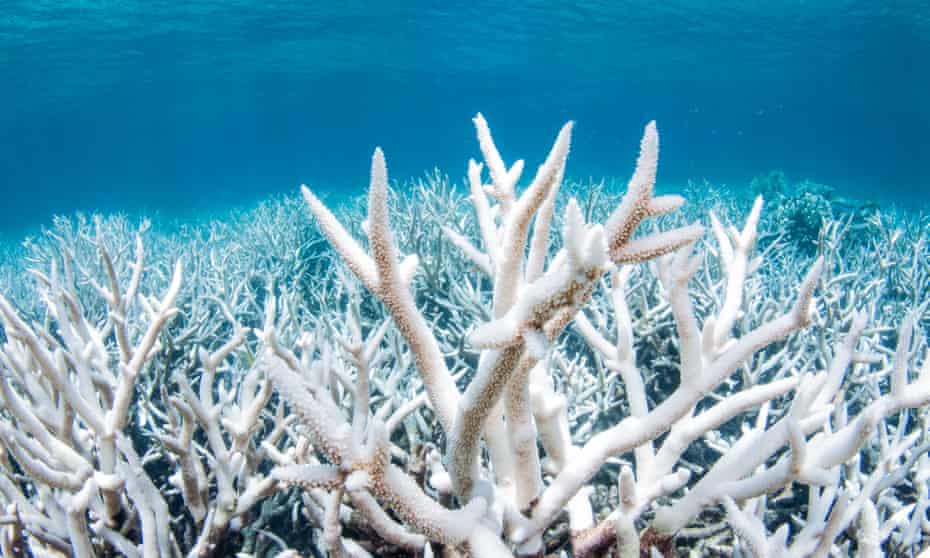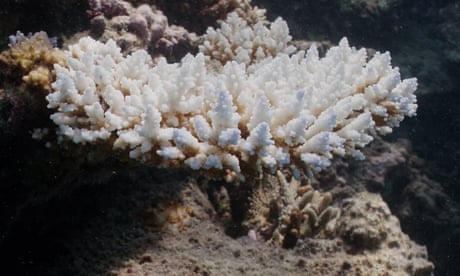Extract from The Guardian
‘We’re not supposed to live in a secret society,’ expert says after agency delays publishing maps of damage.

Thu 5 May 2022 15.17 AEST
Last modified on Thu 5 May 2022 17.57 AESTAerial surveys of the sixth mass bleaching on the Great Barrier Reef were completed in March and are yet to be released. Previous events have been published within two weeks of completion.
The Sydney Morning Herald reported on Thursday that a reef snapshot report on the summer of 2021-22 – which contains the results of the surveys – had been delayed, with the Great Barrier Reef Marine Park Authority telling the newspaper it was unlikely to be released before the federal election.
The aerial surveys pinpoint the locations on the world heritage reef that have been affected by the bleaching, the first to occur under La Niña conditions.

The reef is divided into four management areas and the authority confirmed in March there was widespread bleaching in all four zones.
Prof Terry Hughes, from James Cook University, has conducted the aerial surveys during previous mass bleaching years and said he typically made the maps available within 10 days.
“We’re not supposed to live in a secret society,” he said.
“I think they should release it. There’s a strong similarity here to not releasing the State of the Environment report.”
Hughes said GBRMPA had already verbally described the locations of the bleaching with the worst affected areas in the northern and central regions, with some areas in the south.
He said the information in the report was significant because it would reiterate that the time for corals to recover between bleaching events was getting shorter.
The six mass bleaching events that have occurred on the Great Barrier Reef were in 2002, 2016, 2017, 2020 and 2022.
Hughes said “we will never see again” a 14-year gap between bleachings as occurred between the 2002 and 2016 events.
He said the 2022 summer snapshot was also significant because this year’s event was the first time, due to global heating, that ocean temperatures had been warm enough to trigger bleaching during a La Niña.
The Great Barrier Reef campaign manager at the Australian Marine Conservation Society, Lissa Schindler, said the health of Australia’s reefs and environment was of enormous interest to voters.
“It is vital scientists and Australian voters have up-to-date and transparent information about our environments so they are fully informed heading into an election.”
A spokesperson for the environment minister, Sussan Ley, said three agencies – GBRMPA, CSIRO and the Australian Institute of Marine Science – were working to release the reef snapshot and the timing was at the discretion of those agencies.
“The government has not been offered a briefing on the snapshot and has not issued any instructions in relation to it,” the spokesperson said.
In a statement, a spokesperson for the GBRMPA, said: “The Snapshot is a summary of conditions on the Reef during the summer. Reef health updates are published weekly during the summer and are available on the Reef Authority’s website at gbrmpa.gov.au.”
“Now that summer and the risk level for Reef health has decreased, Reef health updates will now be published monthly,” they said.
“While there is no due date or legislative requirement to publish the Snapshot at a particular time, the Great Barrier Reef Marine Park Authority, the Australian Institute of Marine Science (AIMS) and the CSIRO are working are working to publish the document as soon as practicable.”
A spokesperson from the authority told the Sydney Morning Herald: “The Reef Summer Snapshot 2021-22 was due to be released several weeks ago but has been delayed. It’s the official report released annually that summarises how the reef has fared over summer and features the aerial surveys.”
No comments:
Post a Comment